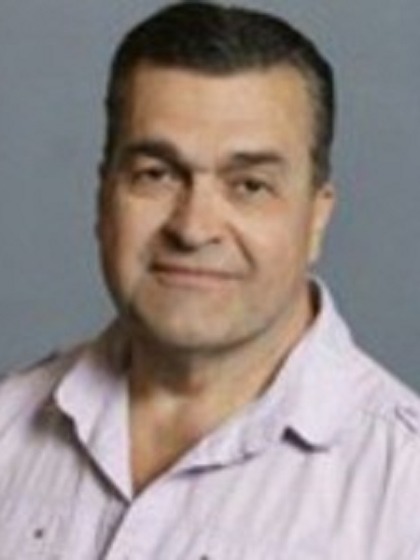G. (George (Georgios)) Palasantzas, Prof

Casimir effect: Casimir forces between macroscopic surfaces have the same physical origin as atom-surface interactions (Casimir-Polder forces) and van der Waals (vdW) forces between two atoms or molecules. In general, Casimir forces result from selective confinement of long-range fluctuations of any field, regardless of its quantum or classical nature, which are encountered in a variety of systems, such as in mixed liquids where it is named the critical Casimir effect, or in the vdW interactions between protein molecules or cellular membranes. vdW forces are crucial in bioassembling including virus-like type objects. Casimir forces have also important technological potential for MEMS/NEMS (switches, accelerometers, quantum levitation systems etc.): they have surface areas large enough but gaps small enough for the Casimir force to draw components together and affect their actuation dynamics. In our research we investigate how surface roughness and material optical properties affect Casimir forces and as a result actuation dynamics of MEMS/NEMS.
Surface roughness effects on DLVO forces between functionalized surfaces: The Derjaguin, Landau, Verwey, and Overbeek (DLVO) theory accounts for the two major forces acting at nanoscale separations between surfaces with a liquid as intervening medium, namely, the electrostatic double-layer and van der Waals (vdW) or Casimir forces as understood via Lifshitz theory. Studies have shown qualitatively that the DLVO interaction energy between rough surfaces can differ considerably from that between smooth surfaces, particularly near the repulsive interaction energy barrier where the reduction in the energy barrier can be correlated with the roughness magnitude. However, more research is still necessary for DLVO forces as a function of surface roughness and material optical properties, as well as the surface wetting state, which are known to strongly influence both vdW/Casimir and double-layer forces. Addressing the role of roughness is an essential direction. Therefore, our aims in the project are twofold: (i) Gain improved understanding and control of surface forces in liquid environments by chemical modification of the wetting behaviour of surfaces (hydrophobic-hydrophilic combinations) using self-assembled monolayers (SAMs) in relation to surface morphology, optical properties, and wetting state; (ii) Attain optimum separation ranges between surfaces where the involved interactions change from attractive to repulsive for technology applications.
Casimir force control by reversible amorphous-crystalline phase transitions: Currently there are strong endeavors to control the Casimir force magnitude with a suitable choice of designed materials. This motivated our attempts to design the dielectric properties of materials in order to produce in-situ switchable Casimir forces between high and low force states. Since phase-change materials (PCMs) are promising candidates to achieve significant reversible Casimir force contrast without composition changes, we aim to: i) Produce and test various PCMs that allow in-situ significant Casimir force contrast due to amorphous - crystalline phase transitions in response to a simple stimulus, ii) Achieve significant Casimir force contrast during in-situ high repetition switching rate of PCMs paving the way for applications in actuation dynamics of micro / nanoelectromechanical systems.
Repulsive Casimir forces from topological insulators towards device actuation:
Due to the unique properties of their surface states, topological insulator materials can potentially open new windows of opportunities for the actuation of future micro/nanoelectromechanical systems. At the same time, the omnipresent Casimir interactions between metallic and dielectric surfaces in close proximity will inevitably need to be faced, with particular attention given to troublesome phenomena such as stiction due to irreversible adhesion of moving parts by surface forces when they come at close nanoscale proximity. Hence, a natural question to ask is how the Casimir force would manifest itself in these novel materials as they interact with each other and other materials that are present in operating systems. So far, the Casimir force has been predicted only theoretically to become repulsive by controlling the sign of the topological magnetoelectric polarizability and the distance between the interacting TI surfaces in the separating ranges of 100 nm. Therefore, we aim to demonstrate experimentally repulsive Casimir forces and explore its effect on stiction phenomena during the actuation of micro/nanodevices.
Nanoparticles: Nowadays monometallic and bimetallic nanoparticles (NPs) have emerged as key materials for important modern applications in plasmonics, catalysis, biodiagnostics, energy storage, and magnetics. Consequently the control of NP structural motifs with specific shapes provides increasing functionality and selectivity for related applications. However, producing bimetallic NPs with well controlled structural motifs still remains a formidable challenge. In our research we investigate NPs for hydrogen storage, wetting, magnetism, solar cells, and phase change materials.
Wetting & surface nanostructures: Wetting of liquids over material surfaces is a topic studied for the last 200 years from both the fundamental and application point of view. Just to mention a few examples, wetting is important for self-cleaning, anti-icing, the adhesion of material surfaces, stiction issues in micro-electromechanical systems (MEMS), capillarity phenomena, reduced fluid drug in micro/nanofluidic systems etc. Moreover, trapping of water drops by modification of surface wettability can play important role for the efficiency of drop condensation from vapor in heat exchangers and fog harvesters. The surface wettability is measured by the contact angle θ between a water droplet and the surface it is attached to. A surface that gives a contact angle (CA) smaller than 90° is termed as hydrophilic, while one with larger than 90° is termed as hydrophobic. The creation also of superhydrophobic surfaces has attracted enormous attention, where examples in nature include the feathers of ducks, butterfly’s wings or the leaves of the lotus plant. In our research we investigate how surface roughness effects the wetting state of surfaces.
AIPScilight: Unanswered questions about the application of Casimir forces
Predicted and proven, but yet to be tamed: uncovering the mysteries of the Casimir force
Interesting articles to read for Casimir Physics & related topics:
Casimir force still surprising
Introductory articles on the Casimir effect
Casimir effect put to work as a nano-switch (New Scientist)
Specialized papers on Casimir effect (Optical properties & Topology):
Optical properties: paper-1, paper-2, paper-3, paper-4, paper-5, paper-6
Topology: paper-1, paper-2, paper-3, paper-4, paper-5
Casimir Force Contrast Between Amorphous and Crystalline Phases
Surface kinetic Roughening
